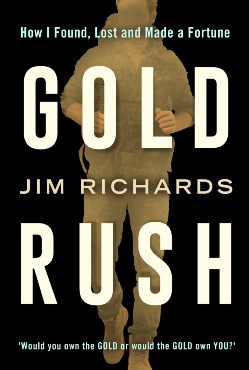 Gold Rush – how I found, lost & made a fortune
Gold Rush – how I found, lost & made a fortune
It was a pleasure to meet geologist and former parachute regiment solider Jim Richards when he delivered a lecture to the North West Regional Group of the Geological Society on this, an autobiography of his career in gold mining and an epic geological tale of rocks, survival and endurance at the most inhospitable ends of the Earth.
This is a no-holds-barred account of life at the sharp end of the exploration industry and, much like the man himself, it comes across as genuine and honest. The people are real, and the situations Jim vividly describes are as raw and real as they can get.
Jim tackles the thorny issue of providing accounts of events in which real people do not always display themselves in the best light with tact and diplomacy, and isn’t afraid to share his own mistakes. As a former gold miner myself, it rang true on so many levels and brought back many happy (and somewhat dusty) memories of rock logging. There is plenty of geological description in here, and so much to be learnt from Jim’s long field experience.
Along with thoroughly entertaining and informative anecdotes of gold, diamonds, oil, iron and more gold, there’s a whole lot of guns, greed, sex, terrorism, corruption, disease and politics thrown in to boot. A representative of seemingly every corner of the animal kingdom has a go at him at one time or another, providing nightmarish encounters with rats, vampire bats, mosquitos, leeches, snakes, and perhaps the deadliest animal of all: the investment banker.
Jim’s geological knowledge and his belief in his dream pull him through: he never gives up, and it is his tenacity of spirit and enthusiasm for geology that bring forth a tale of triumph in the face of adversity, the true possibilities of human achievement in the worst of circumstances and with the smallest of resources, for those who dare to walk the path. There’s many genuine laugh-out-loud moments too. The encounter with Mitch The Canadian’s handover notes had all of us rolling in the aisles.
An absolute must-read for any aspiring exploration geologist, it’s also thoroughly digestible for non-geologists and a handily sized and nicely bound book complete with an interesting set of colour photo illustrations. If you like to read about genuine adventure and survival, then this is for you. AND it has rocks in it. What more could one ask?
Reviewed by Catherine Kenny
GOLD RUSH - HOW I FOUND, LOST AND MADE A FORTUNE by JIM RICHARDS, 2016. Published by: September Publishing 363pp ISBN: 9781910463369 List Price: £10.99. W: www.septemberpublishing.org
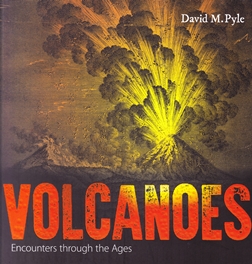 Volcanoes: Encounters through the Ages
Volcanoes: Encounters through the Ages
Even if you didn't think you had any interest in either volcanoes or historical geological documents and references, a visit to the Volcanoes exhibition which was held at the Weston Library in Oxford from February to May 2017 will surely have changed your mind.
The exhibition, based on original documents, books and volcano-related ephemera dating from ancient to modern times from the extensive collections held by the Bodleian Library was nothing short of spectacular and totally absorbing (see the review of the exhibit by Andrew Robinson in ‘2017 Book Reviews’, GeoscientistOnline). Along with the chance to view rarely displayed original material, the exhibition was notable for the quality of the captioning, which explained just the right amount of the geological basics to put the historical material on display into context. With such a wealth of material on show, it took me several visits to take it all in.
Volcanoes: Encounters through the Ages is the book of the exhibition. It was clearly designed as a souvenir – albeit a fairly expensive one – to serve as a useful reminder of what the exhibit contained. However, unlike the exhibition itself, which I found totally absorbing, the book is a bit of curate's egg – that is, very good in parts.
On the plus side it is beautifully produced and includes many wonderful reproductions of some of the documents and early photographs which featured in the exhibit. These range from clear reproductions of manuscript diary pages and letters from people who viewed eruptions first hand, to early 20th century photographs and paintings of volcanoes and volcanic phenomena, and even old film posters designed to fire the public imagination. The text descriptions that accompany the illustrations seem to expand on the original exhibition captions and are informative and fascinating.
But the book also attempts to serve as an introduction to volcanology for the general reader, and this, I feel, is its weak point. Admittedly, it's not easy to explain the complexities of volcanoes to non-specialist readers. However, in contrast to the generally stylish and informative writing about the historical context, the science writing often seems clumsy and occasionally unintentionally patronising – an impression not helped by the excessive use of explanatory phrases in parentheses.
My advice: skip the Introduction, skim through the other 'science textbook' sections and focus instead the historical sections and wonderful illustrations. You'll be in for a fascinating, enjoyable and informative read and a feast for the eyes.
Reviewed by Nina Morgan
VOLCANOES: ENCOUNTERS THROUGH THE AGES BY DAVID M PYLE. Bodleian Library, Oxford, 2017, 223 pp. ISBN 978 1 85124 459 1 List price: £20/US$35.00
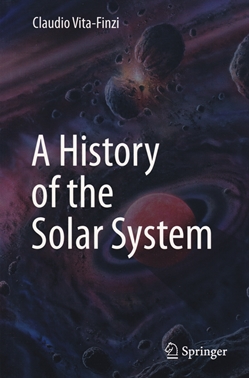 A History of the Solar System
A History of the Solar System
This an unusual book, packed with information, and a difficult one to review. Rather than discuss the evolutionary history of the solar system (as I expected), Vita-Finzi chooses to talk about the history of some ideas that have come about and developed through the study of our planetary neighbours. Each idea is assigned a chapter followed by a list of references.
To explain what the author’s approach is all about, we must go back to 1584, when Giordano Bruno first suggested our planets revolved around the sun. Now, we know there is a multitude of planets orbiting similar stars to ours in our galaxy. That’s a pretty good, and relevant, idea!
In another chapter, the author explores the idea that the solar system is still changing. External ingressions must have had an influence. Vita-Finzi discusses a variety of potential influencers and our present ability to measure their effect.
This is a challenging read. Long sentences are common. They are replete with subsidiary clauses, which make parts of the text difficult to absorb. I often found I had to read a sentence several times to fully understand the gist. And, sometimes a word had obviously been dropped, which made me feel uneasy about my comprehension overall. Such blemishes are irritating and detract from the underlying value.
Despite these problems with editing, the book is cleverly conceived and a useful addition to any scientists bookshelf. It should provide a challenging read to students and graduates alike. Many seasoned scientists may enjoy taking a stab at it too.
In many ways, I understand and admire this brave attempt to conjure up a fresh and more interesting way to examine our local system. I hope there are better books to come.
Reviewed by David Edwards
A HISTORY OF THE SOLAR SYSTEM by CLAUDIO VITA-FINZI. 2016 Springer. 100pp, sbk ISBN: 978-3-319-33848-4 ISBN ebook: 978-3-319-33850-7. W: http://www.springer.com/gb/book/9783319338484
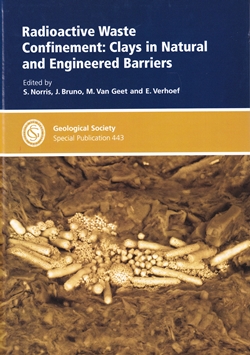 Radioactive Waste Confinement: Clays in Natural and Engineered Barriers
Radioactive Waste Confinement: Clays in Natural and Engineered Barriers
The current scientific consensus for the safest long-term management of higher-activity radioactive wastes is through geological disposal in engineered facilities constructed at an appropriate crustal depth, within stable geological formations (the geological disposal facility or ‘repository’). Repository development on a specific site requires the integrated and systematic analysis of the characteristics of the waste to be ‘emplaced’, the enclosing engineered barriers and the site’s host rock and its geological setting. Three main host rock types are usually considered for geological disposal: crystalline rocks, evaporites (salt) and clays.
This GSL Special Publication concentrates on the importance of clays and other argillaceous materials in the development of geological disposal systems. Characteristically, clays display properties which can be exploited both as host rock and material for engineered barriers (as buffer, backfill or sealing material). Properties include low permeability, diffusive transport, retention capacity, buffering effects, self-sealing capacity, stability, vertical homogeneity and lateral continuity, which make clays significant barriers to radionuclide and chemical contaminant migration towards the surface environment.
Based upon the 6th International Clay Conference hosted by the Belgium National Radioactive Waste Management Agency (ONDAF/NIRAS) in 2015, the volume contains 25 papers grouped into six interrelated and multi-disciplinary topic areas: large-scale geological characterisation, general strategy for clay-based systems, geomechanics, mass transfer, bentonite evolution and gas transfer. These topic areas demonstrate the diversity of current geological repository research. Clay characterisation studies relevant to the confinement of radionuclides range from the fundamental process level, to the overall understanding of the performance and safety at geological and repository scales. Emphasis is placed on the modelling of processes operating at the mineralogical level within the argillaceous barriers.
The contributions are well-written and edited, complemented with appropriate figures, photographs and data-tables. A minor presentational criticism is that several data graphs are difficult to discriminate, reproduced as grey-scale images in the print copy - unfortunately distracting from the details described. Overall, a recommended read and valuable reference work for practising geoscientific professionals within the radioactive waste management sector.
Reviewed by Mark Griffin
RADIOACTIVE WASTE CONFINEMENT: CLAYS IN NATURAL AND ENGINEERED BARRIERS by NORRIS. S, BRUNO J, VAN GEET M, & VERHOEF E (editors). Geological Society of London Special Publication No 443. 2017. Geological Society of London. ISBN 978-1-78620-273-4. Hbk. 376pp. ISSN 0305-8719. List Price: £100.00, Fellows’ Price: £50.00. W: www.geolsoc.org.uk/SP443
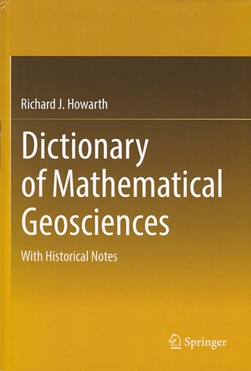 Dictionary of Mathematical Geosciences
Dictionary of Mathematical Geosciences
Browsing a dictionary is one way of picking up a foreign language, if there is no ready access to a native speaker. To the extent that the names of mathematical methods are generally as foreign to geologists as the names of rocks are to mathematicians, this substantial dictionary of mathematical geosciences should be welcomed as a weighty addition to geological libraries.
In the modern digital era, where Google can provide instantaneous answers for any dictionary query, the need for a dictionary in paper or electronic format may be questioned. However, as with language dictionaries, the act of looking up something can serendipitously lead to an extra gain of knowledge. Nobody who browses this dictionary can fail to learn something interesting, even if tangential to their original query.
Any dictionary of mathematical geosciences of finite size carries the personal imprint of the compiler. Richard Howarth received his PhD at the University of Bristol and specialized in the statistical interpretation of geological and geochemical data as well as the history of the use of quantitative methods in geology and early geophysics. He worked for Shell International where he undertook computer programming and statistical analysis for a research project relating the hydrocarbon production of world-wide sedimentary basins to their geology.
As an Imperial College lecturer in the Applied Geochemistry Research Group, he researched the application of statistical and computing methods to mapping and interpretation of regional geochemical survey data for mineral exploration, geological and epidemiological purposes.
Howarth’s broad experience in industry and academia qualifies him as much as anyone else to produce his dictionary of mathematical geosciences, but inevitably some subjects are treated in greater depth than others. His personal interest in the history of the development of quantitative methods is evident throughout, with abundant references to geoscientists who have made substantial contributions.
Some readers may be disappointed that their own particular field of geoscientific enquiry is not as well represented as those with which Howarth is most familiar from his own career. Hopefully, this disappointment will be compensated by the reward of finding new nuggets of information and insight that may prove very useful. Some readers may be delighted to find some topics treated in considerable detail, bordering that of a basic mathematical dictionary. Being expensively priced, this volume is unlikely to be found outside libraries (though an e-book is available); but there it should be often browsed.
Reviewed by Gordon Woo
DICTIONARY OF MATHEMATICAL GEOSCIENCES WITH HISTORICAL NOTES by RICHARD J HOWARTH 2017 Springer International Publishing ISBN 978-3-319-57314-4 (hbk). 893 List Price: £222.50 e-Book: £178.00 W: www.springer.com/gb/book/9783319573144
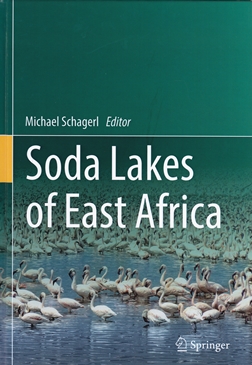 Soda Lakes of East Africa
Soda Lakes of East Africa
There are many reasons for writing and publishing a book, but I suspect the best and most satisfying is ‘fun’. Having now read this latest multi-author publication I firmly believe the 30 different authors had this as their primary motivation.
This book is probably not the last word on the subject of soda lakes, but it is certainly a milestone in characterization and understanding. Covering geology, geochemistry, limnology, zoology, microbiology, environmental and cultural assessment of the soda lakes of East Africa, particularly those of Kenya, this volume provides comprehensive coverage.
The editor, Michael Shagerl (who is also a contributor), has done an extremely good job of assembling like-minded enthusiasts. Starting with an assessment of the physio-chemical environment of the lakes, their formation, hydrology and geochemistry, the book then moves to their associated fauna and microfauna. The final chapters cover issues of conservation and environmental assessment, the challenges in managing the lakes, and potential future scenarios. Despite the comprehensive nature of the chapters, the volume ends with a ‘shopping list’ of issues that still need resolution in our understanding of these unique environments.
The book would seem, at first glance, to be aimed at a highly specialized audience; but if you take a step back from the title, you realise on reading it that the volume is a blueprint for how one should assess an ecosystem - from understanding its geological formation and characteristics, to the micro and macro fauna (and looking to the future to assess potential conflicts and knowledge gaps).
I would therefore recommend this book to any geoscientist. It allows the reader to see how our science interplays with other natural sciences, and the close interconnection between geosphere and biosphere. The book is extremely well edited and the chapters well written: a lasting testimony to the considerable effort the editor and authors have applied. Strongly recommended for anyone who thinks about our natural world.
Reviewed by Rob Bowell
SODA LAKES OF EAST AFRICA by MICHAEL SCHAGERL (ed) 2017. Springer International Publishing ISBN 978-3-319-28620-4 (hbk) 408pp, List price: £100.50. eBook £80.00. W: http://www.springer.com/gb/book/9783319286204